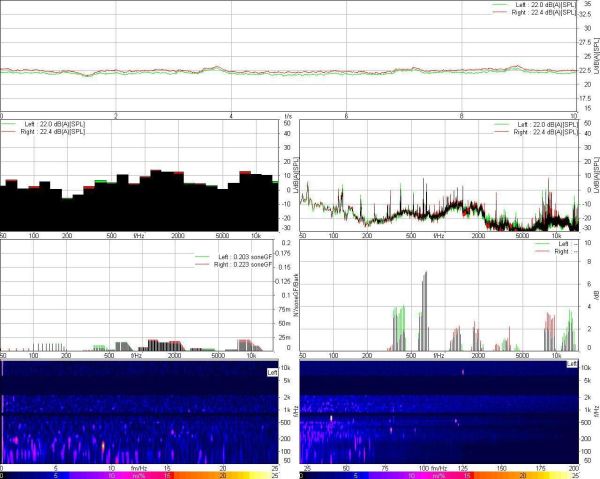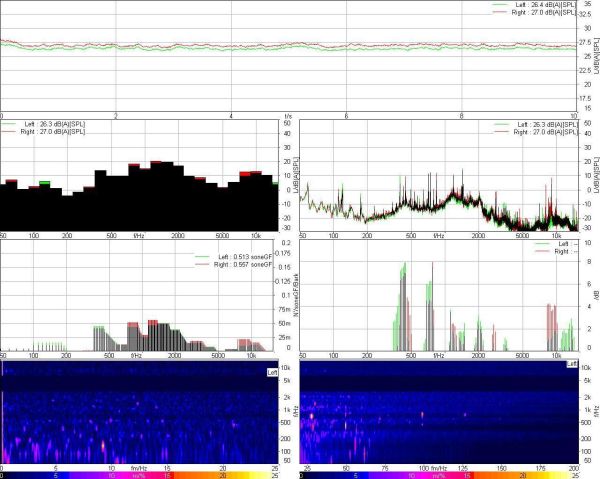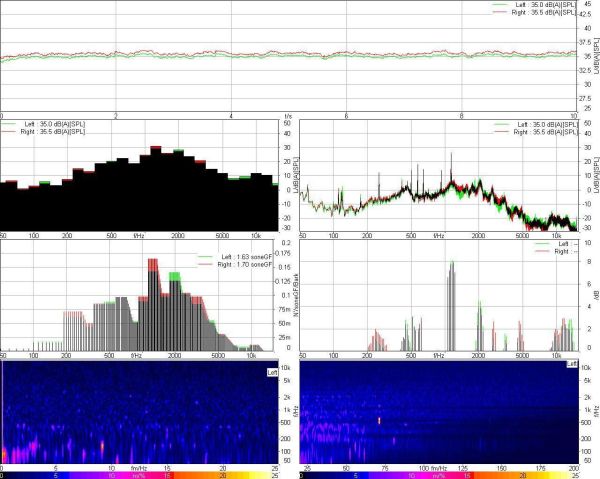ASRock CoreHT 252B Review
by Ganesh T S on September 2, 2011 3:45 AM EST- Posted in
- HTPC
- Intel
- ASRock
- Media Streamer
HTPC enthusiasts are rightly concerned about the noise factor, heat and power consumption, ease of usage and many other criteria. We will tackle each of these concerns one by one in this section.
Noise
ASRock doesn't make any claims about the quietness of the system in their marketing material. We were pleasantly surprised upon looking at the noise reports. In the set of pictures below, a professional sound level detector was placed less than 2 ft away from the CoreHT, and the sound level measurements were taken in various HTPC scenarios. The unit has a noise level of less than 36 dB at full load (for both CPU and GPU). In this respect, it is actually similar in performance to the earlier SFF HTPCs from ASRock.
22.4 dB at Idle
27 dB during Disc Playback
35.5 dB at Full Load (Prime95 + Furmark)
Power Consumption
In order to get an idea of the power consumption numbers, the Prime95 and Furmark benchmarks were let run overnight to keep both the CPU and GPU completely loaded for an extended duration. Under these extreme conditions, we found the average power consumption to be around 62.8 W. At idle, the average power consumption was around 18 W.
These type of power consumption numbers have been enabled by ASRock's choice of going in for a notebook platform instead of a desktop configuration. This has resulted in a smaller form factor case design for the mini-ITX motherboard. Since there is not much heat to be dissipated, the cooling system is also appropriately small and silent.
Ease of Use
HTPC enthusiasts are concerned about how easy it is for their system to come out of standby. Existence of HDMI handshake issues upon return from standby is also a deal breaker for many. Fortunately, the CoreHT 252B has no issues in these two aspects. As long as the AC power adapter is connected to the system, the bundled MCE remote can be used to boot the system (even if the PC had been shut down previously). In order to shorten the boot times, ASRock supplies an Instant Boot utility. Using this, whenver the CoreHT is shut down, it boots up once again and shuts down before the power can be safely removed. Upon power up, the boot up is instantaneous. The MCE remote can also be used to bring the PC out of sleep mode.
Power users can also take advantage of the AXTU (ASRock eXtreme Tune Up) utility for greater overclocking control.
Within Windows, the MCE remote can be made to work with a variety of applications such as XBMC, MediaPortal, MPC-HC and of course, Windows 7 Media Center. Blu Ray players such as PowerDVD and ArcSoft TMT can also be controlled with the help of the MCE remote. For the ideal I/O scenario, one probably needs to purchase a wireless keyboard / mouse combo.













54 Comments
View All Comments
DocJones - Friday, September 2, 2011 - link
I've been wanting to put together a media server with an i5 CPU just about down this line. I currently run Mezzmo as the server software since it does a pretty good job at transcribing video on the fly based on what device is requesting it.I wonder if this has enough juice to transcribe 1080p and send it over the wire to our media players, and if so... can it do more than one?
ganeshts - Friday, September 2, 2011 - link
For a server type situation, I would recommend a desktop chipset.However, the i5-2520M is very very capable.. Maybe you should ask Mezzmo whether they can take advantage of QuickSync?
DocJones - Friday, September 2, 2011 - link
i5 2405S better?http://ark.intel.com/products/55446/...he-2_50-GHz...
Something this form factor would be nice if it worked. Mezzmo folks pretty much say I need a true 4 core 8 thread CPU to perform transcoding on the fly. I find that hard to believe. Others have noted that a Intel Core 2 Quad Q8400 LGA775 'Yorkfield' 2.66GHz 4MB-cache while hot handles the job just fine.
They use ffmpeg so I don't think they support QuickSync right now.
ganeshts - Friday, September 2, 2011 - link
Being paid software, I think Mezzmo needs to pull up its socks and adopt QuickSync for its transcoding operations. I think they can afford to sign whatever NDAs are required for this purpose (Actually, I don't think they need any because Andrew Van Til (www.babgvant.com) has actually implemented QuickSync support in his DVRMSToolBox program).Please hound them about this. I am also personally interested in finding out whether QuickSync is flexible enough for media server software to take advantage of.
blckgrffn - Friday, September 2, 2011 - link
I would hope that this guy starts under $500, but seeing the prices on the Core HT100 at greater than $700, my enthusiasm is tempered a bit.icrf - Friday, September 2, 2011 - link
Agreed, for $500, I'd buy one.Since this is mostly laptop parts, what does a similarly spec'd laptop cost? No keyboard, touchpad, or screen saves some costs. What does this add that a laptop doesn't? A token remote control?
ganeshts - Friday, September 2, 2011 - link
Remote control + IR receiver and form factor combined with scale of manufacturing mean that the cost almost works out to be the same as that of a laptop.For many, a laptop can double up as a HTPC (even I used my notebook as a HTPC between 2005 and 2007), but PCs like these cater to those who need a quiet unobtrusive unit as part of the living room cabinet. Plus, this is a desktop replacement, i.e, you can schedule recordings with an external TV tuner when you are away from the home (or any other such usage scenario).
In the end, it is about horses for courses :)
cknobman - Friday, September 2, 2011 - link
ZBOX nano AD10cjs150 - Friday, September 2, 2011 - link
Initial reviews look very promising although probably best to get the bare bones version and kit out with own memory and an SSD.When available I am going to get one and play with it to see how well it works
icrf - Friday, September 2, 2011 - link
Agreed. It's likely less than half the price, and I can do without an optical drive. I plan to run Windows, so the Linux driver situation around AMD's video decoding hardware don't apply, either (assuming that hasn't been straightened out since I last read about it).Still, it is nice to have all that extra CPU power available for whatever the future brings. I'm just not sure it's going to be worth the several hundred dollars more they're likely going to be asking for it.
In any case, I'd still love to see a review here on the unit, comparing it to this one as a budget alternative. I am a big XBMC proponent (and Hulu Desktop), so I really liked seeing the detailed focus on it, something I'd like to see carried forward in future HTPC reviews.